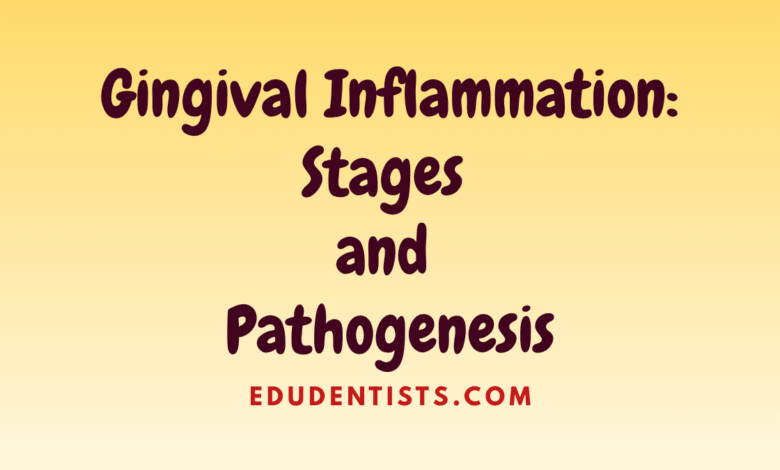Gingival Inflammation: Stages and Pathogenesis

Gingival Inflammation
Stages and Pathogenesis
Gingivitis is an inflammatory condition of the gingival tissues induced by bacterial plaque accumulation at the gingival margin. It progresses through a series of histopathologic stages, each marked by distinct vascular, cellular, and connective tissue changes. These stages reflect the host’s immune response to microbial challenge and determine whether the lesion resolves or progresses into advanced periodontal disease.
Stage I: The Initial Lesion (2–4 Days)
This earliest stage of gingivitis is subclinical and characterized by vascular dilation and increased gingival blood flow. Histologically, polymorphonuclear neutrophils (PMNs) infiltrate the junctional epithelium and adjacent connective tissue. Capillary dilation, endothelial activation, and early leukocyte migration occur. Gingival crevicular fluid (GCF) increases, although clinical signs are typically absent. If plaque accumulation persists, the lesion may progress.
Stage II: The Early Lesion (4–7 Days)
Clinical signs such as erythema and bleeding on probing begin to appear. There is capillary proliferation and formation of capillary loops between developing rete pegs in the junctional epithelium. Lymphocytes, primarily T cells, dominate the cellular infiltrate. PMNs continue migrating into the gingival sulcus, performing phagocytosis and releasing lysosomal enzymes. Collagen destruction becomes significant—up to 70% of perivascular collagen may be lost, mainly affecting the circular and dentogingival fibers.
Stage III: The Established Lesion (14–21 Days)
This chronic stage exhibits pronounced inflammation, with clinical signs such as swollen, discolored gingiva. Venous stasis and impaired blood flow lead to a bluish-red hue. Plasma cells become the predominant immune cell, infiltrating deep into the connective tissue, surrounding blood vessels and collagen bundles. The junctional epithelium displays widened intercellular spaces, filled with granular debris and lysosomes from degraded immune cells. Rete peg formation is prominent, and basal lamina breakdown may occur. Collagen degradation progresses due to host-derived collagenase and bacterial enzymes. Although this lesion may persist for months or years, it does not always progress to periodontitis.
Stage IV: The Advanced Lesion
This stage marks the transition from gingivitis to periodontitis, with inflammatory extension into the alveolar bone and periodontal ligament. It is characterized by attachment loss, bone resorption, and pocket formation, and is discussed further under periodontal disease.
Table: Stages of Gingival Inflammation
| Stage | Time | Blood Vessels | Junctional & Sulcular Epithelium | Predominant Immune Cells | Collagen | Clinical Findings |
|---|---|---|---|---|---|---|
| I. Initial Lesion | 2–4 days | Vascular dilation, vasculitis | Infiltrated by PMNs, widening of intercellular spaces | PMNs | Perivascular collagen loss begins | Subclinical; increased gingival crevicular fluid |
| II. Early Lesion | 4–7 days | Vascular proliferation, loop formation | Rete peg formation begins, dense PMN infiltration | Lymphocytes (mostly T-cells), PMNs, macrophages, plasma cells | 70% collagen loss around infiltrate | Erythema, bleeding on probing |
| III. Established Lesion | 14–21 days or more | Vascular congestion, sluggish flow, blood stasis | Rete pegs advanced, widened spaces with debris, basal lamina damage | Plasma cells predominate, with PMNs, lymphocytes, macrophages | Severe collagen destruction, increased collagenase activity | Changes in color (reddish-blue), size, consistency, texture |
| IV. Advanced Lesion | Variable; may take months | Extension into periodontal tissues | Apical migration of JE, epithelial ulceration may be seen | Plasma cells + inflammatory cells extend deep | Invasion into alveolar bone, connective tissue breakdown | Periodontitis (bone loss, pocket formation) |
Key Highlights by Stage:
⚫ Stage I – Initial Lesion (Subclinical Gingivitis)
- First response to plaque accumulation.
- No visible signs.
- PMNs migrate to sulcus; minor vascular and collagen changes.
🔴 Stage II – Early Lesion
- First clinical signs: redness, bleeding on probing.
- Intense infiltration of lymphocytes, PMNs, and monocytes.
- Start of epithelial proliferation (rete pegs).
- 70% collagen loss, mainly dentogingival/circular fibers.
🔵 Stage III – Established Lesion
- Chronic gingivitis.
- Plasma cells dominate the infiltrate.
- Bluish-red gingiva, sluggish blood flow.
- Widespread collagen degradation, high lysosomal and enzymatic activity.
- Ground substance breakdown.
⚫ Stage IV – Advanced Lesion
- Transition to periodontitis.
- Inflammatory infiltrate invades deeper structures (bone).
- Clinical features now include attachment loss, bone resorption, and deep pockets.
Pathogenesis of Gingival Inflammation
The development of gingivitis involves a complex interaction between bacterial biofilm products—such as collagenase, hyaluronidase, endotoxins—and the host immune response. These microbial agents disrupt epithelial integrity and connective tissue matrix, increasing tissue permeability and enabling the infiltration of inflammatory cells. Activated macrophages and monocytes release pro-inflammatory cytokines like prostaglandin E2, interleukin-1 (IL-1), and tumor necrosis factor-alpha (TNF-α), further amplifying tissue destruction and sustaining the inflammatory cascade.

